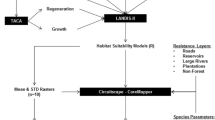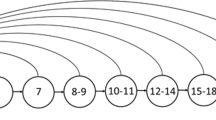Abstract
This paper reports the outcomes of a novel inter-twining of long-term monitoring data and population modelling to assess the accuracy of predictions of a Population Viability Analysis (PVA) model. In particular, the relative effectiveness of different management options for reserving areas from timber harvesting was assessed for two forest-dependent arboreal marsupials, the greater glider (Petauroides volans) and Leadbeater's Possum (Gymnobelideus leadbeateri). We used data from 7 years of monitoring conducted at 161 sites to assess and modify, where appropriate, previous population models of the two species of arboreal marsupials. The results indicated that the importance of food resources for both had been underestimated in past work. Despite this, the modified models that included increased importance of food availability did not change the predicted risks of decline substantially, particularly for Leadbeater's Possum. Importantly, past conclusions about the optimal sizes of patches to reserve within the forests used wood production were robust to changes in the model. This is a valuable finding because the work we report is one of the first to empirically test the robustness of the relative predictions of a PVA model. Nevertheless, the new insights we derived from this study have implications both for: (1) the implementation of our ongoing long-term monitoring study, in particular the value of what can be termed ȁ8adaptive monitoring', and, (2) the establishment of a new silvicultural experiment designed to better create habitat for arboreal marsupials within logged and regenerated sites.
Similar content being viewed by others
References
Adams M.H. and Attiwill P.M. (1984). The role of Acacia spp. in nutrient balance and cycling in regenerating Eucalyptus regnans F. Muell. forests. 1. Temporal changes in biomass and nutrient content. Aust. J. Bot. 32: 205–215
Ashton D.H. (1975). The root and shoot of Eucalyptus regnans F. Muell. Aust. J. Bot. 23: 867–887
Ball S., Lindenmayer D.B. and Possingham H.P. (2003). The predictive accuracy of viability analysis: a test using data from two small mammal species in a fragmented landscape. Biodivers. Conserv. 12: 2393–2413
Beissenger S.R. and McCullough D.R. (2002). Population Viability Analysis. University of Chicago Press, Chicago
Beissenger S.R. and Westpahl M.I. (1998). One the use of demographic models of population viability in endangered species management. J. Wildlife Manage. 62: 821–841
Brook B.W., O'Grady J.J., Burgman M.A., Akçakaya H.R. and Frankham R. (2000). Predictive accuracy of population viability analysis in conservation biology. Nature 404: 385–387
Burgman M.A., Ferson S. and Akçakaya H.R. (1993). Risk Assessment in Conservation Biology. Chapman and Hall, London
Commonwealth of Australia and Department of Natural Resources and Environment. (1997). Comprehensive Regional Assessment – Biodiversity. Central Highlands of Victoria. The Commonwealth of Australia and Department of Natural Resources and Environment, Canberra, Australia
Comport S.S., Ward S.J. and Foley W.J. (1996). Home ranges, time budgets and food-tree use in a high-density tropical population of greater gliders, Petauroides volans minor (Pseudocheiridae: Marsupialia). Wildlife Res. 23: 401–19
Cunningham R.B. and Welsh A.H. (1996).. Report to The Australian Nature Conservation Agency, Canberra, Australia
Department of Environment and Heritage. (2005). Department of Environment and Heritage Australia, Canberra
Franklin J.F., Harmon M.E. and Swanson F.J. (1999). Complementary roles of research and monitoring: lessons from the U.S. LTER Program and Tierra del Fuego. Paper presented to the SymposiumToward a unified framework for inventorying and monitoring forest ecosystem resources, Guadalajara, Mexico
Goldsmith B. (1991). Monitoring for Conservation and Ecology. Chapman and Hall, London
Henry S.R. (1984). Social organisation of the greater glider (Petauroldes volans) in Victorea. In: Smith, A.P. and Hume, I.D. (eds) “Passions and Gliders”, pp 222–228. Surrey Beatty & Sons, Sydney
Hellawell J.M. (1991). Development of a rationale for monitoring. In: Goldsmith, F.B. (eds) Monitoring for Conservation and Ecology, pp 1–14. Chapman and Hall, London
Holling C.S. (eds). (1978). Adaptive Environmental Assessment and Management. International Series on Applied Systems Analysis 3, International Institute for Applied Systems Analysis. John Wiley, Toronto
Kavanagh R.P. and Lambert M.J. (1990). Food selection by the Greater GliderPetauroides volans: is foliar nitrogen a determinant of habitat quality?. Aust. Wildlife Res. 17: 285–299
Kehl J. and Borsboom A. (1984). Smith, A.P. and Hume, I.D. (eds) Possums and Gliders, pp 229–236. Australian Mammal Society and Surrey Beatty and Sons, Sydney
Lindenmayer D.B. (1996). Wildlife and Woodchips: Leadbeater's Possum as a Testcase of Sustainable Forestry. University of New South Wales Press, Sydney, 156
Lindenmayer D.B. (2000). Factors at multiple scales affecting distribution patterns and its implications for animal conservation – Leadbeater's Possum as a case study. Biodivers. Conserv. 9: 15–35
Lindenmayer D.B. (2002). Gliders of Australia. A Natural History. University of NSW Press, Sydney, 160
Lindenmayer D.B., Cunningham R.B., Tanton M.T. and Smith A.P. (1990). The conservation of arboreal marsupials in the montane ash forests of the Central Highlands of Victoriasouth-east Australia. II. The loss of trees with hollows and its implications for the conservation of Leadbeater's Possum Gymnobelideus leadbeateri McCoy (Marsupialia: Petauridae). Biol. Conserv. 54: 133–145
Lindenmayer D.B., Cunningham R.B., Tanton M.T., Nix H.A. and Smith A.P. (1991a). The conservation of arboreal marsupials in the montane ash forests of the Central Highlands of Victoriasouth-east Australia. III. The habitat requirements of Leadbeater's PossumGymnobelideus leadbeateri McCoy and models of the diversity and abundance of arboreal marsupials. Biol. Conserv. 56: 295–315
Lindenmayer D.B., Craig S.A., Linga T. and Tanton M.T. (1991b). Public participation in stagwatching surveys for a rare mammal – applications for environmental education. Aust. J. Environ. Educ. 7: 63–70
Lindenmayer D.B., Lacy R.C., Thomas V.C. and Clark T.W. (1993). Predictions of the impacts of changes in population size and of environmental variability on Leadbeater's PossumGymnobelideus leadbeateri McCoy (Marsupialia: Petauridae) using Population Viability Analysis: an application of the computer program VORTEX. Wildlife Res. 20: 67–86
Lindenmayer D.B., Cunningham R.B. and Donnelly C.F. (1994). The conservation of arboreal marsupials in the montane ash forests of the Central Highlands of Victoriasouth-east Australia. VI. Tests of the performance of models of nest tree and habitat requirements of arboreal marsupials. Biol. Conserv. 70: 143–147
Lindenmayer D.B. and Possingham H.P. (1995). The conservation of arboreal marsupials in the montane ash forests of the Central Highlands of Victoriasouth-east Australia. VII. Modeling the persistence of Leadbeater's Possum in response to modified timber harvesting practices. Biol. Conserv. 73: 239–257
Lindenmayer D.B. and Possingham H.P. (1996). Ranking conservation and timber management options for Leadbeater's Possum in southeastern Australia using Population Viability Analysis. Conserv. Biol. 10: 235–251
Lindenmayer D.B. and Franklin J.F. (1997). Forest structure and sustainable temperate forestry: a case study from Australia. Conserv. Biol. 11: 1053–1068
Lindenmayer D.B., Cunningham R.B. and Donnelly C.F. (1997). Decay and collapse of trees with hollows in eastern Australian forests: impacts on arboreal marsupials. Ecol. Appl. 7: 625–641
Lindenmayer D.B. and Lacy R.C. (2001). Small mammals, patches and PVA models: a field test of model predictive ability. Biol. Conserv. 103: 247–265
Lindenmayer D.B. and Franklin J.F. (2002). Conserving Forest Biodiversity: A Comprehensive Multiscaled Approach. Island Press, Washington, 351
Lindenmayer D.B. and Franklin J.F. (2003). Towards Forest Sustainability. CSIRO Publishing, Melbourne
Lindenmayer D.B., Possingham H.P., Lacy R.C., McCarthy M.A. and Pope M.L. (2003a). How accurate are population models? Lessons from landscape-scale population tests in a fragmented system. Ecol. Lett. 6: 41–47
Lindenmayer D.B., Cunningham R.B., MacGregor C. and Incoll R.D. (2003b). A long-term monitoring study of the population dynamics of arboreal marsupials in the Central Highlands of Victoria. Biol. Conserv. 110: 161–167
Lindenmayer D.B., Franklin J.F., Angelstam P., Bunnell F., Brown M., Dovers S., Hickey J., Kremsater L., Niemela J., Norton D., Perry D. and Soulé M. (2004). The Victorian Forestry Rountable Meeting – discussing transitions to sustainability in Victorian forests. Aust. Forest. 67: 1–4
Lindenmayer D.B. and Burgman M.A. (2005). Practical Conservation Biology. CSIRO Publishing, Melbourne
Link W.A., Cam E., Nichols J.D. and Cooch E.G. (2002). Of BUGS and birds: Markov chain Monte Carlo for hierarchical modeling in wildlife research. J. Wildlife Manage. 66: 277–291
Lutze M.T., Campbell R.G. and Fagg P.C. (1999). Development of silviculture in the native State forests of Victoria. Aust. Forest. 62: 236–244
Macfarlane M.A., Smith J. and Lowe K. (1998). Leadbeater's Possum Recovery Plan. 19982–002. Department of Natural Resources and Environment, Government of Victoria
Mackey B.G., Lindenmayer D.B., Gill A.M., McCarthy M.A. and Lindesay J. (2002). WildlifeFire and Future Climate. A Forest Ecosystem Analysis. A Forest Ecosystem Analysis. CSIRO Publishing, Melbourne
McCarthy M.A. and Lindenmayer D.B. (1998). Multi-aged Mountain Ash forestwildlife conservation and timber harvesting. Forest Ecol. Manage. 104: 43–56
McCarthy M.A. and Lindenmayer D.B. (1999). Incorporating metapopulation dynamics of Greater Gliders into reserve design in disturbed landscapes. Ecology 80: 651–667
McCarthy M.A. and Lindenmayer D.B. (2000). Spatially correlated extinction in a metapopulation model of Leadbeater's Possum. Biodivers. Conserv. 9: 47–63
McCarthy M.A., Masters P. and in press. Profiting from prior information in Bayesian analyses of ecological data. J. Appl. Ecol.
McCarthy M.A., Lindenmayer D.B. and Possingham H.P. (2000). Australian Treecrepers and landscape fragmentation: a test of a spatially-explicit PVA model. Ecol. Appl. 10: 1722–1731
McCarthy M.A., Andelman S.J. and Possingham H.P. (2003). Reliability of relative predictions in population viability analysis. Conserv. Biol. 17: 982–989
McCarthy M.A., Thompson C.J. and Possingham H.P. (2005). Theory for designing nature reserves for single species. Am. Nat. 165: 250–257
Milledge D.R., Palmer C.L. and Nelson J.L. (1991). `Barometers of change': The distribution of large owls and gliders in Mountain Ash forests of the Victorian Central Highlands and their potential as management indicators. In: Lunney, D. (eds) Conservation of Australia's Forest Fauna, pp 53–65. Royal Zoological Society of NSW, Mosman
O'Grady J.J., Reed D.H., Brook B.W. and Frankham R. (2004). What are the best correlates of predicted extinction risk?. Biol. Conserv. 118: 513–520
O'Shaughnessy P. and Jayasuriya J. (1991). Managing the ash-type forest for water production in Victoria. In: McKinnell, F.H., Hopkins, E.R. and Fox, J.E.D. (eds) ForestManagement in Australia, pp 341–363. Surrey Beatty and Sons, Chipping Norton
Possingham H.P., Lindenmayer D.B. and Norton T.W. (1993). A framework for improved threatened species management using Population Viability Analysis. Pacific Conserv. Biol. 1: 39–45
Possingham H.P., Lindenmayer D.B., Norton T.W. and Davies I. (1994). Metapopulation viability of the Greater Glider in a wood production forest. Biol. Conserv. 70: 265–276
Possingham H.P., Lindenmayer D.B. and McCarthy M.A. (2001). Population Viability Analysis. Encyclopedia of Biodiversity 4: 831–843
Reed D.H., O'Grady J.J., Brook B.W., Ballou J.D. and Frankham R. (2003). Estimates of minimum viable population sizes for vertebrates and factors influencing those estimates. Biol. Conserv. 113: 23–34
Ringold P.L., Alegria J., Czaplewksi R.L., Mulder B.S., Tolle T. and Burnett K. (1996). Adaptive monitoring design for ecosystem management. Ecol. Appl. 6: 745–747
Smith A.P. (1984). Smith, A.P. and Hume, I.D. (eds) Possums and Gliders, pp 359–373. Surrey Beatty and Sons, Chipping Norton
Spellerberg I.F. (1994). Monitoring Ecological Change 2nd edn. Cambridge University Press, Cambridge
Spiegelhalter D., Thomas A., Best N. and Lunn D. (2003). WinBUGS User Manual Version 1.4.. MRC Biostatistics Unit, Cambridge
Taylor B., Kremsater L. and Ellis R. (1998). Adaptive Management of Forests in British Columbia. British Columbia Ministry of Forests – Forest Practices Branch, Victoria, British Columbia
Tyndale-Biscoe C.H. and Smith R.F. (1969). Studies of the marsupial gliderSchoinobates volans (Kerr). III. Response to habitat destruction. J. Anim. Ecol. 38: 651–659
Walters C.J. (1986). Adaptive Management of Renewable Resources. Macmillan Publishing Company, New York
Walters C.J. and Holling C.S. (1990). Large scale management experiments and learning by doing. Ecology 71: 2060–2068
Welsh A.H., Cunningham R.B. and Chambers R.L. (2000). Methodology for estimating the abundance of rare animals: seabird nesting on North East Herald Cay. Biometrics 56: 22–30
Author information
Authors and Affiliations
Corresponding author
Rights and permissions
About this article
Cite this article
Lindenmayer, D.B., Mccarthy, M.A. Evaluation of PVA Models of Arboreal Marsupials: Coupling Models with Long-term Monitoring Data. Biodivers Conserv 15, 4079–4096 (2006). https://doi.org/10.1007/s10531-005-3367-7
Received:
Accepted:
Published:
Issue Date:
DOI: https://doi.org/10.1007/s10531-005-3367-7




